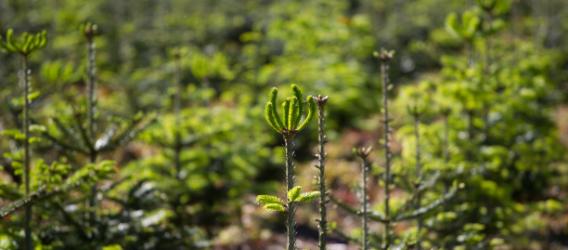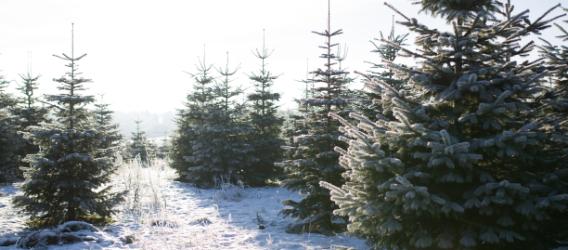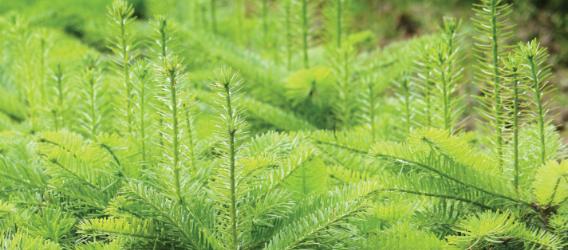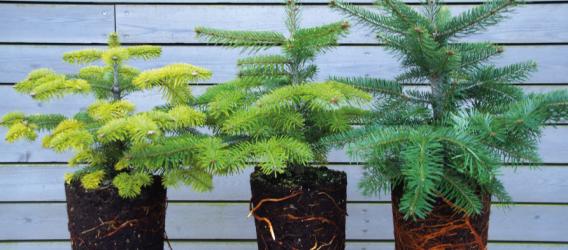
Provenances and species for Christmas trees and greenery
A Christmas tree is not just a Christmas tree.
It might be difficult to see the wood for the trees, when it comes to provenances and species within the Christmas tree and greenery production.

The most common species for Christmas trees and greenery production
In the following, you will find information about the most common species of Christmas trees and greenery production in Europe and learn which soil types and climatic conditions are suitable for the various trees.
There are many different species and provenances of nordmann fir and other conifers and it is important to consider which production you want as well as taking into account the climatic and soil conditions when deciding which species you want to grow.


Abies nordmanniana Apsheronsk
- Region: North Caucasus, Russia
- Meters above sea level: 800-950 m
- Climate: Subcontinental to continental
- Bursting: Late
- Growth: Narrow to medium width
- Needle length: Long
- Density: Poor
Abies nordmanniana Apsheronsk is the tree with the best origin for planting in climatically difficult areas. This tree is very hardy to frost during the winter months. With Apsheronsk you will get a narrower tree than e.g. Ambrolauri Tlugi.
Characteristics and use of Apsheronsk
Apsheronsk has smaller internodes and is thus a tree with less fullness than e.g. Arkhyz. After planting the Abies nordmanniana Apsheronsk grows a little slower than other origins.
Apsheronsk is a narrower tree than e.g. Ambrolauri Tlugi, but both origins are very suitable for production of both Christmas trees and greenery.
Growing and harvest of Abies nordmanniana Apsheronsk
You can grow this tree in pots as well as on the field, as long as the soil is well drained and has a pH-value of 5.5 - 6.5. That said, the tree can grow on most soil types as long as it is placed in full sunlight.
Abies nordmanniana can be cut into shape and often requires top leader regulation. To avoid damages to the needles caused by lice and gall mites, most often you will have to control vermin.
The production time for a Christmas tree of this origin with a height of 1.75 - 2 m will be about 9-12 years.
Abies nordmanniana Ambrolauri
- Region: Caucasus, Georgia
- Meters above sea level: 1150-1400
- Climate: Coastal
- Bursting: Middle
- Growth: Very wide and dense
- Needle length: Very long
- Density: Very good
Most of the seed material used in the nordmanniana types originates from Ambrolauri, Tlugi slopes in Georgia.
Ambrolauri is also the most used origin for Christmas trees in Western Europe, because of the nice symmetry, the density of the needles and the ability to keep the needles after felling.
Characteristic and use of nordmanniana
Besides the needle density, this provenance is characterized by many branches in the whorl, many internodegenres on the trunk, a fine branch angle and a relatively late bursting. These characteristics ensure a high yield of salable trees and reduce the risk of frost damages in spring.
Abies nordmanniana Ambrolauri Tlugi is suitable for production in pots and also on the field. The tree is very suitable as a Christmas tree and for greenery.
Growing and harvest of nordmanniana
In terms of cultivation, this tree needs a well drained soil with pH-value 5.5 - 6.5. This provenance is not suitable for frost exposed areas, but can grow on most soil types. However, the tree requires full sunlight.
Can be cut into shape and often requires top leader regulation and control of lice and mites.
The production time for a Christmas tree on 1.75 - 2.0 m is about 9-12 years.


Abies lasiocarpa
- Region: Northern USA and Canada
- Meters above sea level: 1.700-1.800
- Climate: Continental
- Bursting: Early
- Needle lenght: Good
- Density: Poor
Abies lasiocarpa, the alpine fir, originates from the northern part of the USA and Canada, where it grows naturally in the mountains. Under these conditions, the tree can grow up to 20 meters high.
Characteristics and use of alpine fir
The alpine fir has a slim growth with short and horisontal to upright branches. The bark is smooth and greyish on the young trees. The needles are bluish and makes the tree incredibly beautiful and decorative - and keeps the needles for a long time after felling.
Abies lasiocarpa is a very popular Christmas tree in Norway and Sweden, but also very popular as an ornamental tree in parks and gardens.
Growing and harvest of Abies lasiocarpa
The tree thrives on a well drained soil. Long periods with humid weather and wet soil will expose the alpine fir to rot and needle fungus.
This tree is easy to cut into shape. It is very hardy to wind and winter, but a late night frost in spring can, however, damage the tree.
Abies bornmuelleriana
- Region: West Turkey
- Meters over sea level: 1200-1400
- Climate: Subcontinental
- Bursting: Early
- Growth: Medium width
- Needle length: Good
- Density: Poor
Abies bornmuelleriana is a close relative to Abies nordmanniana. An excellent high growth and the stature of the tree make it more regular than the Abies nordmanniana.
Characteristics and use of Abies bornmuelleriana
This tree likes to grow upwards. The needles are stiff and are placed all the way around the branches which makes the tree look ample. The underside of the needles is light and gives the tree a silvery sheen.
Growing and harvest of Abies bornmuelleriana
The regular form of this tree is very populuar, and there may be a higher yield of saleable trees and even more primate trees in a culture with Abies bornmuelleriana than in a culture with Norwegian fir.
However, the early bursting makes the tree vulnerable to night frost in spring and the special needling means that this provenance is not suitable for greenery.


Krasnaja
- Region: Northern Caucasus, Russia
- Meters above sea level: 1400-1600
- Climate: Subcontinental
- Bursting: Late
- Growth: Narrow to medium width
- Needle length: Short
- Density: Poor
Krasnaja is especially suitable for planting in subcontinental areas. The winter hardiness for this provenance is one of the best among the Georgian provenances; only Apsheronsk and Arkhyz are more suitable.
Characteristics and use of Krasnaja
If you choose this tree for your Christmas tree culture you will get a narrower tree with short needles and a relatively poor density. Is this the type of tree your customers want, then Krasnaja is a good choice.
Growing and harvest
The late bursting makes the tree suitable for areas with a risk of frost in the spring.
Krasnaja is a fast growing tree and will be ready for sale already after 7-8 years.
Borshomi
- Region: Little Caucasus, Central Georgia
- Meters above sea level: 800-1400
- Climate: Maritime to continental
- Bursting: A little later than Ambrolauri
- Growth: Medium width
- Needle length: Very long
- Density: Very good
The Borshomi tree is better to withstand winter frost than Ambrolauri and is therefore not plaqued by dead buds after severe frost.
Characteristics and use of Borshomi
Borshomi is a regular and beautiful tree with long, dark green needles, a medium width and high density. A Christmas tree most people will like.
Growing and harvest
This tree is suitable for many different climates.
Compared to Ambrolauri, Borshomi has a fast growth after planting and generally a better shape.
The number of prima trees in a Borshomi culture will usually be higher than in an Ambrolauri culture.


Beshumi
- Region: Little Caucasus, South Georgia
- Meters above sea level: 1800-2000
- Climate: Maritime to continental
- Bursting: Later than Ambrolauri
- Growth: Medium width
- Needle length: Long
- Density: Very good
When growing Beshumi trees you will get a tree very suitable for especially the production of greenery.
Characteristics and use of Beshumi
This origin has a dense and rather narrow growth but with long needles and a good fullness.The dense and bushy needle setting makes the tree suitable for greenery.
Growing and harvest
After planting, the Beshumi has a very slow growth, so you must be aware that the culture needs some time for development.
The species is not hardy to winter frost.
Artvin-Savsat-Yayla
- Region: Little Caucasus, Turkey
- Meters over sea level: 1600-1800
- Climate: Subcontinental-continental
- Bursting: Middle
- Growth: Narrow
- Needle length: Short
- Density: Good
With this origin, you will get at tree suitable for cultures with a short rotation.
Characteristics and use
Artvin-Savsat-Yala is a tree with a very fast growth after planting, and is therefore very suitable for growing small Christmas trees and for cultures with little space between the rows.
The colour of the needles is remarkably nice and deep dark green, if you fertilize correctly.
Growing and harvest of Artvin-Savsat-Yayla
When planting Artvin-Savsat-Yayla on good soil types, you must expect some growth regulation, since this species is growing fast. With the correct growth regulation you can, however, expect a beautiful tree where frost damage is very rare, and due to the fast growth it is suitable for the production of small trees.


Tversted F 527
- Region: Northern Jutland, Denmark
- Meters above sea level: 50
- Climate: Maritime to subcontinental
- Bursting: Middle
- Growth: Medium to wide
- Needle length: Very long
- Density: Very good
Tversted F 527 is a descendant of Borshomi, from which it has its best characteristics: less dead buds after winter frost, fast growth after planting as well as a nice shape.
Characteristics and use of Tversted F 527
Due to the harsh climate in Northern Jutland, Tversted F 527 is more winterhardy than its predecessor, the Borshomi. This species has a high utilization. Tversted F 527 is a good choice when you want to grow trees for greenery and with the nice shape, it is most suitable for becoming a Christmas tree.
Growing and harvest
Like its predecessor Borshomi this tree is very suitable for different climates and is because of its winter hardiness a good choice for e.g. the Danish climate.
In contrast to Ambrolauri Tversted F 527 has a good growth quickly after planting and a generally nicer shape.
In terms of utilization Tversted F 527 is also better than Ambrolauri. Growing Tversted F527 trees means more trees of prime quality in your culture.
Abies fraseri
- Region: Smokey Mountains, North Carolina and West Virginia
- Climate: Subcontinental
- Bursting: Middle
- Growth: Narrow
- Needle length: Short
- Density: Poor
Abies fraseri, the East American fir is the most poupular tree in the Christmas tree production in the USA. On the East Coast, this species constitutes 90% of the assortment of the Christmas trees.
Characteristics and use of Abies fraseri
This narrow tree is easy to shape into the sought after cone shape that the Americans like. By cutting the tree into shape, it will also become denser which many people demand.
The East American fir has a good needle firmness which is very popular in the USA.
Growing and harvest of East American fir
Should you want to grow "American trees" you should choose Abies fraseri. It is easy to shape and is a perfect "beginner's tree".


Abies koreana
- Region: South Korea
- Meters above sea level: 1.000-1.900
- Climate: Continental
- Bursting: Late
- Growth: Narrow
- Needle length: Short
- Density: Poor
When you choose to grow Abies koreana you will get a hardy and very decorative tree.
Characteristics and use of Abies koreana
Abies koreana is a compact, smaller tree with dark green needles and is one of the most beautiful conifers we have. Abies koreana grows slower than many other conifers and rarely grows higher than 15 m.
When the tree is about one meter high, it starts to grow small cones which are upright on the branches. The cones are purple to violet blue and very decorative. They develop during the summer and will break up when winter comes.
Abies koreana is suitable as a Christmas tree, for production both in pots and in the field. Worldwide, this decorative tree is popular in parks and gardens.
Growing and harvest of Abies koreana
Abies koreana requires full sunlight but is very hardy to wind and frost, both in the winter and spring time. Easy to cut into shape. Can grow on most soil types and is resistant to fungal diseases.


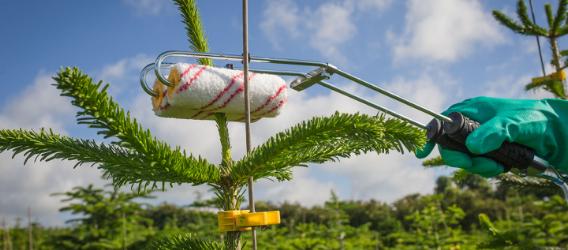
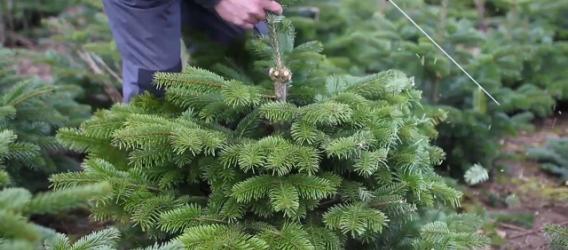
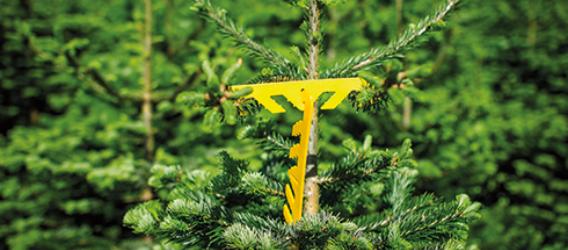
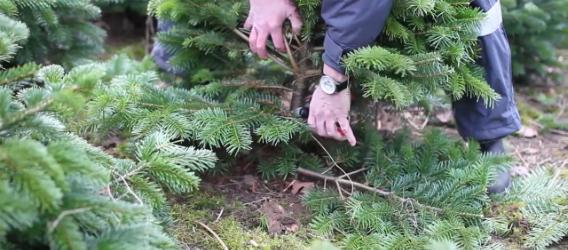
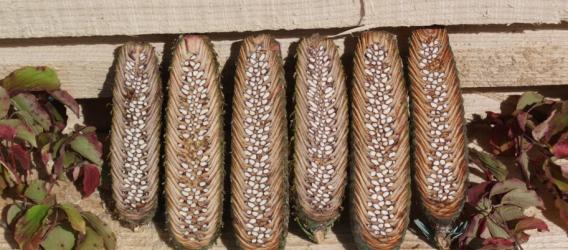
.jpg)
